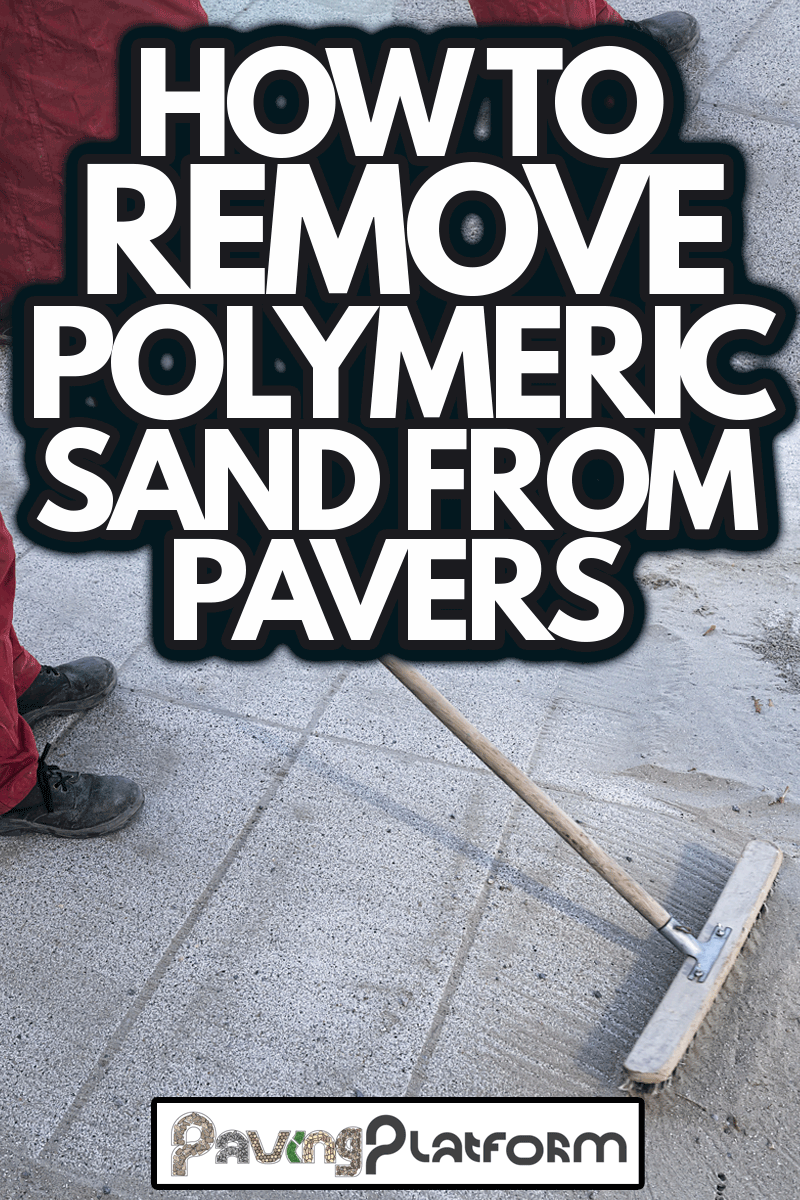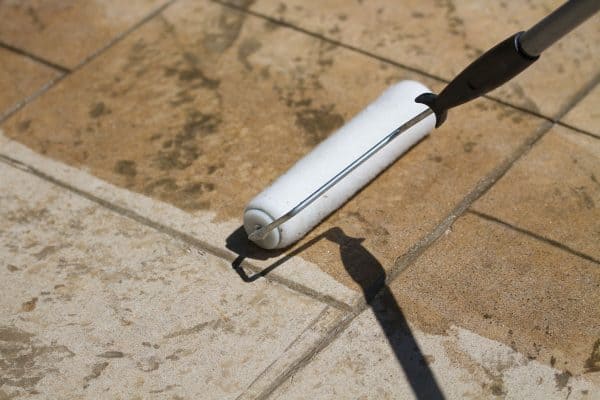Disclosure: We may get commissions for purchases made through links in this post.
Over the years, polymeric sand has improved and made its name on the market. And that is the reason why most homeowners choose it for their pavers. But do you know how to remove polymeric sand from pavers without damaging them? In this post, we will provide the answer to that.
There are three simple and easy steps to follow to solve your problem:
- Avoid the polymeric sand running into water as much as possible. It is best to clean it when it is dry.
- Use a broom with soft bristles; never try to use a wire brush. Sweep the pavers thoroughly but gently to avoid damaging the surface. Repeat this step as many times as you wish until the polymeric sand residue is removed or deposited into the joints of the paver.
- To blow the stubborn residue off, use a leaf blower.
It is necessary to follow the detailed guidelines when removing polymeric sand on your pavers. Doing so will limit the possibility of damaging the pavers. Continue reading until the end to know more information about polymeric sand.

How To Remove Hardened Polymeric Sand
When the polymeric sand is in contact with water, it will harden. But there is no need to worry about it. You can still pull out the hardened polymeric sand from your pavers, although it will be a bit difficult.
The effort you will have to provide will depend upon the thickness of the hardened polymeric sand. If it is thin, you can wash it effortlessly using a garden hose. But if the hard polymeric sand is thick, you will not be able to wash it off just by using a garden hose.
Can I Use High-Pressure Water to Remove Polymetric Sand
If the polymeric sand is not yet removed even after days of washing, it is time to use a pressure wash. And there is one keyword here. If it is not necessary we suggest not to use it. To clarify, using it can potentially damage your project.
Common Mistakes In Using Polymeric Sand
The biggest mistake someone can make is not reading the product's instructions. If you want your hardscape to have a perfect finish, we suggest you read and follow the manufacturer's instructions at all times.
Enumerated below are the most common mistakes in using polymeric jointing sand.
1. Pavers and Joints Are Wet
Avoid installing polymeric sand when the area is wet. If you install it in such a situation, the sand will activate immediately without even spreading it equally to the joints yet. You don't want to clean hardened polymeric sand for sure.
2. Not Thoroughly Removing The Excess
You might consider this the worst mistake when installing polymeric sand. Ignoring and not planning to remove the residue above the pavers will surely give you a headache. If excess sand particles get wet and activated, it will be difficult for you to remove them. And worse, it will be harder to put the sealant because the sand will firmly crust above the pavers.
3. Over or Under-Watering
The key to achieving well-bonded polymeric sand is the precise amount of water you apply.
Over-Watering
Putting too much water can lead to the detachment of the sand from the polymer during the activation. In addition, the binding of the sand and polymer will decrease because the sand won't harden completely.
Under-Watering
An inadequate amount of water can result in a sand crust on top of the pavers. As a result, the joints cannot bond appropriately. In time, it will have cracks and gaps.
4. Overfilling Your Joints
It is the most significant factor that every homeowner should know. If you think filling your joints more can deliver a better bonding, you are incorrect. Ensure to leave about 1/8 inches above to avoid over-spilling.
5. Poor Drainage
Pavers should have a base that will allow water to drain through. Without proper drainage, the whole project will surely get disrupted and ruined.
6. Improper Size Of Joints
Too narrow or too wide joints can result in poor bonding and the appearance of polymeric sand.
Acutely narrow joints can cause an overabundance of polymeric sand. As a result, the sand will be pushed out from the joints while activating. On the other hand, vastly wide joints can lead to a mess. It will result in a sand washout because of too much water flowing.
Advantages and Disadvantages of Polymeric Sand
Of course, every construction material has its pros and cons. And we want to be fair in giving you information. That is why we have prepared some lists of its benefits and drawbacks that you should be aware of.
Polymeric Sand Advantages
Have you ever wondered why homeowners mostly choose polymeric sand over regular jointing sand? If you tried having one already, you probably know the answer by now.
1. Durable
When you install polymeric sand in your pavers, you can expect that it is better in terms of security and sturdiness compared to other regular jointing sand. Thanks to the binding agent that the polymeric sand has. It ensures that the sand is stable. And it makes the pavers well-anchored, as well.
Polymeric sand also offers immense help in extending the lifespan of your paver project.
2. Polymeric Sand is Stationary
If you think polymeric sand can loosen easily, you are mistaken. Unlike regular jointing sand that can dissolve easily by rainfalls, polymeric sand is tightly bound to the pavers.
3. Many Colors To Choose From
There are numerous colors of polymeric sand. You can choose any color that will suit your taste or something that will match your pavers. Black, gray, and brown are the standard colors of the polymeric sand, but they come up with many shades of those colors.
4. It Deters Weed
Stubborn weeds? No problem! It is a good thing that polymeric sand deters weed. In other words, moss, grass, and weeds cannot take root from your pavers. All credit goes to the airtight stability of the polymeric sand, to keep unsightly weeds out.
5. Ant Deterrent
Polymeric sand indeed gives us satisfying benefits. Ants cannot build lairs on your pavers with polymeric sand. You can now get your kids to play outside all day, without ants crawling into their pants. Additionally, ants cannot frustrate you anymore with their annoying little bites.
6. Appealing To The Eyes
Aside from giving you a long-lasting and quality hardscape, polymeric sand can also offer you to have an eye-catching finish to your pavers.
Disadvantages of Polymeric Sand
It is necessary to know the disadvantages of something you are dealing with. Doing so will help you weigh whether or not you should purchase and use it for your future projects.
1. You Can Ruin The Hardscape If The Polymeric Sand Is Improperly Installed
Messing the installation up will mean messing the whole hardscape project, as well. In a polymeric sand installation, you have to be at your best because it is not as easy as it seems. You should strictly follow the manufacturer's instructions to install it perfectly. In addition, you have to avoid any mistakes as much as possible to achieve great results.
2. Polymeric Sand Rapidly Gets Hard
When in contact with water, the polymeric sand will harden in a split second. However, this specific disadvantage might be an advantage to some. And it will depend upon the installation situation.
Always check the weather forecast if it's going to rain before starting the installation. Any form of liquid may activate the polymer in no time. To clarify, ensure distributing the polymeric sand equally to the joints before exposing it to water or moisture.
How Long Does Polymeric Sand Last
The lifespan of the polymeric jointing sand will depend on the quality of what you just purchased. But it is known that polymeric sand can last up to 10 years before it needs replacement. However, some manufacturers claim that theirs can last up to 15 years.
Is Polymeric Sand Worth Every Penny
The answer to this question would be up to you. We suggest you go back to the part where we elaborated on the benefits of the polymeric sand. And try to contemplate if those benefits are enough to consider whether the polymeric sand is worth every penny or not.
Check this Camel Brown Polymeric Sand on Amazon.
Final Analysis
Polymeric sand is better than other regular jointing sand because of its benefits. Although removing polymeric sand on your pavers is a bit hard, you can still make it undemanding as long as you follow the guidelines from what we have given you. Also, you can always contact a professional for polymeric sand querries.
Would you like to read more of our articles? Check these out!


![Vibrant Red Paver Stone Path, Can You Spray Paver Sealer? [How To Apply It]](https://pavingplatform.com/wp-content/uploads/2022/04/Vibrant-Red-Paver-Stone-Path-600x400.jpg)
![Properly laid out red pavers for a garden, Can You Tint Paver Sealer? [And How To]](https://pavingplatform.com/wp-content/uploads/2022/04/Properly-laid-out-red-pavers-for-a-garden-600x400.jpg)
